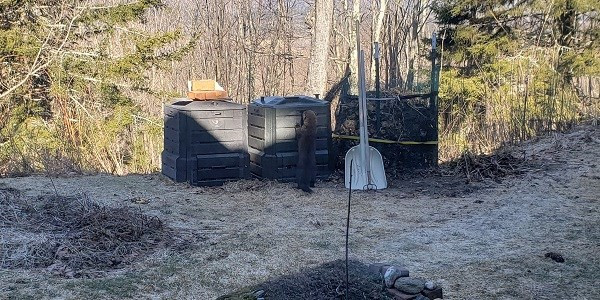We buy peanut butter in a 9-pound bucket. Why do I share this info you ask? One is because we love peanut butter in our household, and two, more to the point, the buckets, once emptied, make great compost buckets.
I seriously love composting. We did it growing up in MA some 50 years ago and I’ve pretty much done it ever since. Over time I have learned that an uncovered simple smallish bucket under the sink works best. We have a few buckets we rotate through. We empty our bucket every one to two days. We wash them in between each uses and this helps to keep the ick factor down. We even run them through the dishwasher. We keep it uncovered to keep the process aerobic, with air, vs anaerobic, without air. Once the food scraps start decomposing anaerobically in the bucket, the bucket gets gross and a gross compost bucket makes the whole process less acceptable. In the summer when fruit flies can be a problem, we’ll put a dishcloth over the bucket to help keep them at bay. This is where emptying and washing the bucket every day is really important.

Our compost set up is pretty simple too. We have two Soil Saver units and one homemade wire unit. Our process goes like this. One Soil Saver unit is active, we’re adding food scraps to it. The second Soil Saver unit is full and resting. The wire unit is finishing. Every few years we’ll empty the wire unit and screen the compost. The screened compost goes into the gardens, used to augment potting soil for house and container plants, or spread around the yard. The uncomposed chunky stuff from the screening process goes back into the active unit.
In late fall, before things freeze up, we empty both Soil Saver units into the wire unit. The active unit’s material goes in first with the resting unit’s material on top. This will help prevent attracting critters. We like going into the winter with two empty Soil Savers as this provides just enough space for our family of four to compost throughout the winter. Since there is no real breakdown of the material during the cold months the units fill faster.
To keep critters out of the active unit we’ll place leaves or several shovels full of material from the wire unit on the pile to knock down any odors. We’ve been hit a few times by bears but that tends to happen right after we’ve emptied the Soil Savers and there is a fresh pile of food scraps in the bottom. Raccoons sometime visit too but weighting down the lid helps keep the smaller critters out. Managing odors from the decomposing process is key. If you have a big bear problem, you may need to consider enclosing your system in electric fence or taking your food scraps to the transfer station…

On July 1, 2020, Vermont state law banned disposal of food scraps in the trash or landfills. Whether you are a pro or beginner composter the VT Department of Environmental Conservation web site has great info about the ins and outs of the law and how to divert food scraps from the waste stream.
A few other tricks for success. Place your compost system in a sunny spot. This aids in the composting process by keeping things warmer and drier. A shady system composts slower, wetter and can be smellier. Keep the system near the house. If you place it too far away it will make it less convenient to empty your bucket frequently. We freeze our meat scraps, bones and fats then bring these to the food scraps tote at the transfer station as our home compost system is too small to handle these and the odors from them will definitely attract critters. Peel off those dang plastic fruit and veggie stickers. They don’t compost! Compostable plastics do not compost in a home compost system either. The same goes for doggie doo bags. Put those in the trash.

